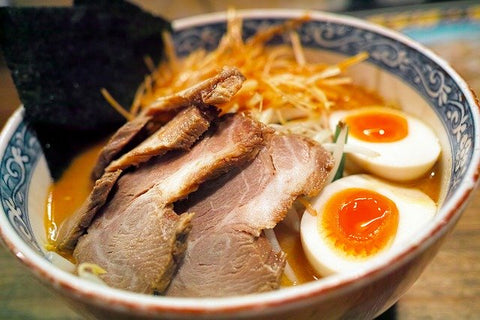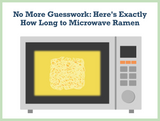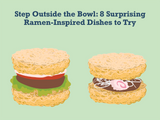
People frequently say to me, "I don't know how to eat ramen”.

So here is how...


1. Sample some of the broth
It is perfectly fine to drink a bit of the soup using your spoon.

2. Pick up a few strands of noodles with your chopsticks
With your chopsticks, pinch a bite-sized amount and lift up to your mouth.
Keep in mind, if you grab too many noodles, you might get a tangly mess which will make it difficult to put into your mouth.
A little tip: Keep your chopsticks aligned, it will help with grabbing the noodles.
3. Slurp away at your noodles!
This is actually the preferable way of eating ramen and other types of noodles.
While slurping is frowned upon in almost all other foreign countries, this Japan-specific gesture is believed to allow the diner to better savor the aroma of the noodles.

Don’t be afraid to make sounds while doing so.
A little tip: Only slurp ramen, udon, soba or any other Japanese noodle dishes. Slurping other foods in Japan is still frowned upon!

4. Eat quickly!
Ramen is actually fast food. You want to eat it quickly while it is still piping hot.
If you wait for too long, not only will the soup and noodles get cold, the noodles will absorb the broth, making it thick and soft and losing its nice chew.

Slurping is a lot harder than it seems!
You think you can't do it?
Don't worry. I've prepared some exercises.
Keep reading and you will find out…
1. What are the benefits of slurping ramen noodles?
2. Unknown history about when people started slurping noodles
3. The only time it is not rude to slurp noodles
4. An elevated way of eating ramen
5. How to practice slurping ramen noodles
6. What should you sample first? Noodles or soup?
7. Must-know taboos of using chopsticks
1. What are the benefits of slurping ramen noodles?
There are some advantages and reasons for using this “slurping” method when eating ramen…
1. You can prevent noodles from getting soggy and soup from getting cold.
If you slurp, you can eat noodles quickly, so you can enjoy its chewiness.
In addition, it is rude to the chef to not eat food as soon as it is served to you.

2. You can enjoy the flavor of ramen at least 4 times more if you slurp.
Having a combination of air, noodles and soup together allows you to feel more flavor in your mouth.

3. Japanese people find it disgusting to bite off excess noodles and for the excess pieces to go back into the soup bowl.
That is why slurping is preferred because you can bring all the noodles into your mouth at once.
Remember that chewing noisily or eating with your mouth open are still bad manners in Japan, but only slurping is OK.
Depending on where you are and which way you are most comfortable with, try out both ways and see which way is the best way for you to enjoy ramen.

2. Unknown history about when people started slurping noodles
When did Japanese people start slurping noodles?
It is a good question.

i. In the Edo period (1603 to 1868), people started slurping soba noodles
Long ago, Tokyo was called Edo.
Soba became popular as a type of fast food among people in Edo.

Because Edo was a very busy city,
The people in Edo invented a way to slurp soba noodles…
Because they had unique characteristics.

1. Edo people were…
Generous with their money, so they didn’t like to save money,
They didn’t care about small things,
They were stubborn, and quick to lose temper,
They liked to tell jokes, but didn’t like to have a debate,
Kind, cry easily, and had a strong sense of justice.
And they loved eating soba noodles.

2. Because people in Edo were very busy
Soba noodles for Edo people are something that you can eat as a snack.
While they ate soba noodles, they didn’t sit.
They ate soba noodles at a food stall while standing.
And they had to eat quickly.
So this is the reason why they started slurping noodles with a noise.
Another reason was…

3. Tables were too low in Edo period
Tables at home, restaurants, or food stalls were all short back in the Edo period.
It was so difficult to eat noodles in this condition.
There is so much effort involved in bringing noodles to your mouth because of the distance, and if it takes too much time, your noodles will get cold.
That is why people started slurping.

ii. Slurping soba became cool
In the Edo period, there were already rules for table manners.
And it is said that you should NOT make any noise while you eat.
However, soba was a fast food and because Edo people didn’t care about small things,
Slurping and making noise while they were eating was fine.
Actually, Edo people found this technique pretty cool.
Edo people had their own unique values called “iki”.
Iki meant being stylish or having a sense of beauty.

iii. Here are some examples of “iki” things.
- Even Though the water in the bathtub is too hot, you don’t complain about the temperature.
-In the very cold winter, wearing a lot of layers of clothing is not cool. You wear only a thin kimono.
-Soba noodles are not the food that fills your stomach. You should have them quickly and by slurping, and you shouldn’t bite noodles.
The sense of “iki” is based on 2 things...
Rebellious spirit,
And the idea of acting cool and composed.
The concept of “iki” that Edo people had, is seen as one of the reasons why we slurp ramen noodles today,
Because the thickness of ramen noodles is similar to soba noodles, and ramen bowls and utensils are also similar to the ones used for soba.

3. Is it rude to slurp ramen noodles?
Well, among the Japanese, slurping is considered bad manners.
However, it is widely accepted.
Because…
People know slurping ramen noodles makes ramen tastier,
Some people find it is a cool way of eating,
And ramen is considered a type of fast food.

i. As I said, slurping is a cool way to eat noodles, but…
I don't think I can slurp ramen noodles in front of His Majesty the Emperor.
I would be so quiet while eating noodles if I were to eat in his presence.
The official manner of Japanese cuisine for eating noodles is...
Eating noodles without any noise.

ii. Then, on what occasion shouldn’t you slurp?
The answer is any formal meal settings.
Like when you are at a kaiseki cuisine restaurant.
If there is soba or udon at a kaiseki place, you should be careful.
But don’t worry about this too much.
Because…
At these high end traditional Japanese restaurants, noodles are cut into proper length by the chefs.
So you can eat them quietly without noise.

4. An elevated way of eating ramen
1. Grab the chopsticks with your dominant hand.
2. Grab the spoon (renge) with your non-dominant hand.
3. Using your dominant hand, pick up a few strands of noodles with your chopsticks.
4. Put the noodles into the spoon.
5. Lift the noodles again using the chopsticks and bring it into your mouth.

The point is using the spoon as a saucer, so you can get rid of the extra soup.
You don’t have to suck noodles in from the bowl, so you will not make any noise when you eat your noodles.

There are some advantages to eating this way...
1. It is easy to eat because you don't need to slurp to enjoy your noodles.
2. Soup doesn't splash from the ends of your noodles, so you can avoid soup stains from getting on your clothes.
3. You can cool down hot noodles using your spoon.
4. You don’t make a mess.
5. It looks more elegant while you eat ramen.

There are some tips for this...
Tip No. 1: The amount of noodles that you put on the spoon is a bite.
It makes it much easier to eat your noodles.

Tip No. 2: Do not eat like a crab
You might think...
Can I eat noodles from the spoon?
Unfortunately, no.
Remember this:
When you eat noodles, you should use your spoon as a saucer.
It is the same idea as table manners in other countries.
You hold your cutlery in both hands, but you only use one of your cutlery to bring food into your mouth.

Tip No. 3: When you want to drink soup, hold the spoon in your dominant hand
As I said, you don’t want to eat like a crab.
It means if you want to drink ramen soup, you have to use your dominant hand to use the spoon.
Here is how...
1.Put your chopsticks down from your dominant hand.
2.Grab spoon with your dominant hand
3.Ladle up soup
4.Drink the soup
When you drink soup from the spoon, your mouth should not touch the tip of the spoon.
Your mouth should touch the side edge of the spoon.

Tip No. 4: This is how to hold your ramen spoon
Do you hold your renge like you hold a regular spoon?
That is actually wrong.
For a regular spoon, you hold it like how you are holding a pen.
However,
When you hold a renge, you fit your index finger on the ditch or the inner handle...
...And hold the renge with your thumb and middle finger.

Did you know that?
Probably you have never really given much thought to the inner crevice of the handle.
Actually, me either.
But have you noticed, it is the perfect size for your index finger?
This inner gap is actually a resting place for your index finger.

Tip No. 5: If there is a hook on the ramen spoon, hook the spoon on the edge of the ramen bowl
To be honest with you, I don't think that eating ramen this way is as tasty as slurping it, so I will now share the most "kakkoii" or cool way to eat ramen in Japan (in my opinion).
When I was young, my mom said to me, "You can make noise when you eat ramen, udon, and soba, but not for spaghetti."
She taught me how to twirl spaghetti on a spoon to eat it.
After that, I knew I must treat non-Japanese noodles differently, but for ramen and other soupy noodles, I developed my own slurping way naturally when observing adults.
Slurping is a lot harder than it seems! You think you can't do it?
Don't worry. I've prepared some exercises.

5. How to practice slurping ramen noodles

Level 1: Slurping Air
Making your mouth as small as possible, inhale air using your mouth and exhale using your nose.
Your mouth should be shaped like you are pronouncing the “O” sound.
After making this shape with your mouth, make a noise like "Suuuuu" when you inhale.
Level 2: Slurping Water
Keep your mouth in an “O”-shape and slurp the surface of a cup of water.
Keep the water inside your mouth and exhale from your nose.
The point of this exercise is learning to slurp and keeping the contents in your mouth while at the same time letting air into your lungs.
The Final Big Boss: Slurping Noodles
Do the same thing you did in the previous step but instead of water this time, you will be slurping noodles.
Use cut noodles and cold soup for practice.

6. Which should you taste first? Noodles or soup?
Now that we've learned two different ways of enjoying ramen, what are you going to eat out of your ramen bowl first?
In the ramen world, a big topic of debate is: "Noodle first or soup first?”
Personally, I prefer drinking a spoon of soup first to catch a glimpse of the overall flavour of the ramen, but today, I will be introducing the two differing point of views.

Ramen consists of mainly soup and noodles.
Both play a very important role in ramen and both are irreplaceable.
You cannot call a bowl of noodles “ ramen” even if one of these two key ingredients is missing.
The reasons why I like to take a sip of soup first...
1. For me, the broth is essentially the “soul” of the ramen.
The soup sets the overall “ ambience” of the ramen I’m about to enjoy.
I want to get to know this taste first to see what I should be expecting.
Soup is unique and different in each restaurant.
The texture of noodles is important, but the most important element of ramen is its flavor and taste.
The differentiating aspect of ramen is the soup.
2. Drinking soup is relaxing and, in its own way, therapeutic.
It warms up your body and relieves stress. This is especially enjoyable in the winter time.
3. The broth is the aspect in which most ramen chefs put their effort into the most.

The reasons why people eat noodles first are...
1. In some ramen restaurants, the soup is used as an “accessory” to the noodles, so therefore, the taste is adjusted to bring out the best taste in the noodles.
This is why sometimes ramen broth is much saltier than regular soup.
2. Because they are hungry and want something filling first.
I personally prefer to drink soup first but I can also see why some people choose to eat noodles first.
Many people don't care about this hot topic in the ramen world and/or don’t even know that this is a real discussion topic for ramen enthusiasts.
Ramen is a local Japanese food, so enjoy it in your own way whether it's slurping loudly or eating quietly with a spoon.
That is the #1 rule for enjoying ramen!

7. Must know taboos of using chopsticks
Whether you are dining in a ramen restaurant in Japan or a Japanese restaurant back home,
Proper chopsticks usage and etiquette should be practiced to show appreciation and respect to the chef who meticulously prepared the meal.
The thought of using chopsticks can be intimidating and even a deterrent for some to try delicious Japanese cuisines, like ramen.
Knowing the general rules and tips, as well as major faux pas will help you master the art of chopsticks and perfect Japanese table manners.
Now that we’ve looked at the proper ways to handle ramen with the help of chopsticks, let’s take a look at some of the major no-no’s.
Things You Should NOT Do with Chopsticks:

1. Don't Stand Your Chopsticks Upright
This is one of the biggest taboos in Japanese chopsticks mannerism as this is a practiced funeral custom.
In Japanese funerals, a bowl of rice with two standing chopsticks are presented in front of an altar with the deceased's photo.
Not only is this considered a major faux pas in Japan, but in many other Asian countries as well.
When your chopsticks are not in use, you should leave it on your chopstick rest.
If one didn't come with your disposable chopsticks, you can easily fold one using the paper wrapper of your chopsticks.
2. Don't Pass Food From Chopsticks to Chopsticks
This is reminiscent of another Japanese funeral custom where cremated bones are ritually passed between two pairs of chopsticks into the urn.
If you want to pass food to another person, you can do so by putting it directly onto their plate.
When you are transferring food from a shared plate to another person's plate or your own plate, never use your own chopsticks.
The front of your chopsticks have been in your mouth and should not be near the shared plate.
You should also not use the back of your chopsticks as they are considered to be dirty since this is where your hands rest.
Instead, ask the server for a pair of toribashi (取り箸) - chopsticks for communal use. These chopsticks rest on shared plates and are used when transferring food from a shared plate onto individual plates.

3. Don't Cross Your Chopsticks
When your chopsticks are not in use, you should have them rested straight and parallel to each other instead of being crossed.
Your chopsticks are seen as a pair and they should always be together side-by-side.
Do not use them like a fork and knife with one chopstick in each hand trying to pry large pieces of food apart.

4. Don't Browse or Dig with Your Chopsticks
Take food from the top of the shared dish.
Don't use your chopsticks to dig through the shared dish for something good.
If you can't decide what to take, take a bit of everything from each dish instead of taking only things that you like.

5. Don't Point with Chopsticks
Do not point at things or people with chopsticks when you are talking, it is seen as bad manners.
When your chopsticks are not in use, you should have them rested.

6. Don't Lick or Suck the Ends of Your Chopsticks
Sucking or licking the ends of your chopsticks, and holding them in your mouth while your hands are occupied are seen as bad manners.
The main purpose your chopsticks serve is to transfer food from your plate into your mouth.
Doing anything outside of this is considered inappropriate.

7. Don't Rub Your Chopsticks Against Each Other
Some people rub disposable wooden chopsticks together to remove splinters. This is seen as rude as it indicates that you think the chopsticks are cheap.
If you need to remove splinters, do so by plucking them off the chopsticks.

8. Don't Swirl Your Chopsticks in Soup
When you swirl your chopsticks in soup or any other liquids at the dining table.
It looks like you are trying to wash it.

9. Don't Stab Your Food with Your Chopsticks
Chopsticks should be used to "pinch" food and brought to your mouth.
Do not stab your chopsticks into the food like a fork. If you are having a difficult time picking up noodles like ramen, use a spoon to help.

10. Don't Eat Directly From Communal and Shared Dishes
Pick up food on a shared plate using the toribashi and put it onto your own plate before eating it.
That's it! After reading all the do's and don'ts on Japanese chopsticks mannerism, you are already on the path of mastering the art of chopsticks.
Don't get too absorbed with the rules of using chopsticks. Even some Japanese people struggle with perfecting chopsticks usage.
If you cannot remember everything you've read here today, just remember the two main chopsticks taboos, which mirror Japanese funeral customs, and make sure not to do those.
Focus on enjoying that bowl of ramen or whatever it is you have in front of you. If you try your best, everything will turn out well.

If ramen or any other types of Japanese style noodles and soup is comfort food for you, you might be thinking that you need ramen bowls.
Ramen bowls are perfect for a large bowl of ramen.
They are big enough to pile on the fixings, they are durable, and best of all, they look beautiful.
Share a bowl of warm, hearty home cooked ramen with your family, friends and loved ones for your ramen night.
Or when you order take out, transfer the noodles from those awful looking containers.
You and your family will be so excited and can’t wait until your next ramen night to use these bowls!
What to Eat with Ramen: See How Easily You Can Be Happy Eating Ramen This Way
About the Author

"I am from Ibaraki, Japan.
Ramen is great! It can bring you a sense of happiness and satisfaction that no other food can. I have been eating ramen for 30 years.
If there is no ramen, my life would be miserable.
Ten years ago, I worked as an office worker. The job was really stressful - excessive working hours, low wages, unpaid overtime work, and constantly being yelled at by my boss.
I was new and alone, no girlfriend, no friends, and felt very lonely.
My only oasis was the ramen shop near the office. For me, the ramen chef there was literally an angel. I saw a halo on his head. (No joke)
Tonkotsu shoyu ramen was my all-time favorite. He made ramen with broth chock-full of umami flavor, nice chewy handmade noodles, and tender chashu.
My greatest dream is connect people with ramen through my blog. I want to share a lot of interesting and funny stories and ramen trivia with you.
Knowing more about ramen can help you appreciate your ramen and make it taste extra delicious."









Leave a comment